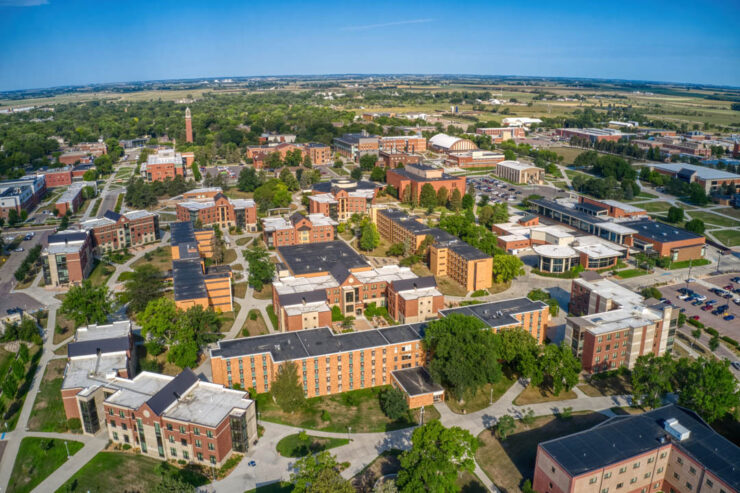Adapting university office spaces to support flexible work arrangements
After successfully operating remotely during the pandemic, many higher education institutions are embracing more permanent flexible work spaces for administrative and professional services employees. In fact, human resource leaders expect nearly four times as many university staff to work in a hybrid arrangement (i.e., splitting their work hours between campus and remote locations) going forward, as compared to a pre-pandemic baseline.
-
6%
Staff working in a hybrid arrangement pre-pandemic
-
23%
Anticipated staff working in a hybrid arrangement post-pandemic
This means that a subset of employees will no longer physically come to campus for work every day. As a result, these hybrid staff may not need as much or the same types of campus workspaces as they did in the past. Campus leaders must therefore begin rethinking their office space strategy. Flexible work spaces offer new opportunities to increase efficiencies and reduce costs by sharing and repurposing administrative offices. At the same time, leaders will still need to ensure hybrid staff have adequate access to individual and collaborative workspaces when on campus.
To better understand universities’ plans for transforming administrative and professional services office space to support hybrid work, EAB surveyed business and facilities leaders at over 50 institutions across the US, Canada, and UK. Read on to learn the main takeaways from the survey results.
1. 58% of surveyed campus leaders are actively planning to redesign their administrative office spaces to better support hybrid work
Historically, institutions designed administrative offices for fully in-person employees who required a dedicated space for independent work each day. Now, with a greater proportion of staff working on campus part-time, almost 3/5 of survey respondents are planning to renovate existing offices with hybrid employees in mind. In doing so, leaders seek to ensure their campuses have the temporary and collaborative spaces that hybrid staff need to make their time working in the office both engaging and productive—and to reduce the number of assigned desks in the office to reflect a smaller in-office population.
2. Shared workspaces and flexible layouts are the top design trends for office renovations
At institutions that are redesigning their administrative offices, 51% are incorporating shared hoteling and hot-desking spaces for hybrid staff to use when they come to campus.
-
What is hoteling?
Workspaces are unassigned on a permanent basis; workers reserve a space in advance to use temporarily on days they will be in the office.
-
What is hot-desking?
Workspaces are completely unassigned; staff occupy them on a first-come, first-served basis at the start of each workday.
Beyond individual workstations, leaders plan to create a range of other shared spaces that will enable employees who are working in the office to meet and collaborate with both in-person and remote colleagues. For example, 45% of survey respondents are creating technology-enhanced meeting rooms that enable seamless video conferencing, 42% are incorporating call rooms for one-on-one conversations, and 38% plan to include huddle spaces for quick team meetings.
Respondents are also interested in flexible office layouts and room configurations that can enable them to more quickly and easily adapt to changing workplace needs: 40% are incorporating design features like mobile furniture and moveable walls, and 38% are adopting open office floorplans.
Design features leaders are incorporating in renovated office spaces
n=55
-
51%
Hoteling or hot-desking arrangements shared by multiple employees
-
45%
Technology-enhanced meeting rooms (e.g., screens and cameras for video conferencing)
-
42%
Small rooms for calls or one-on-one meetings
-
40%
Increased flexibility/modality of furniture and room configurations (e.g., moveable walls)
-
38%
Huddle or collaboration spaces (distinct from traditional conference rooms)
-
38%
Open office floorplans (i.e., decrease in the amount of private offices with doors)
3. 1/3 of surveyed institutions are implementing or upgrading scheduling technology for shared workspaces
With more institutions using hoteling and hot-desking arrangements for hybrid staff, a third of campus leaders are investing in scheduling technology that enables employees to reserve shared desks or spaces. By implementing this technology, leaders hope to minimize staff concerns about no longer having a permanently assigned campus workstation, as well as to gather and monitor data to improve workspace utilization. Among institutions that are using booking software, there is little agreement about the best provider―only two out of 22 leaders referenced the same vendor in their survey response.
4. There is not yet consensus on how much administrative office space campuses will need in the long term
Since many institutions are still in the process of piloting or implementing flexible work spaces across campus, it is not surprising that 30% of survey respondents said they were unable to predict what their office space footprint will look like a decade from now. Interestingly, while there is a lot of buzz about the potential for flexible work spaces to enable long-term cost and space savings, just over 40% of respondents anticipate needing less office space across the next decade. 23% of leaders foresee needing the same amount, and 7% said they will likely need more office space in the future.
Across the next decade, do you anticipate your institution needing:
n=61
- Less office space: 41%
- Not able to anticipate yet: 30%
- The same amount of office space: 23%
- More office space: 7%
More Blogs
